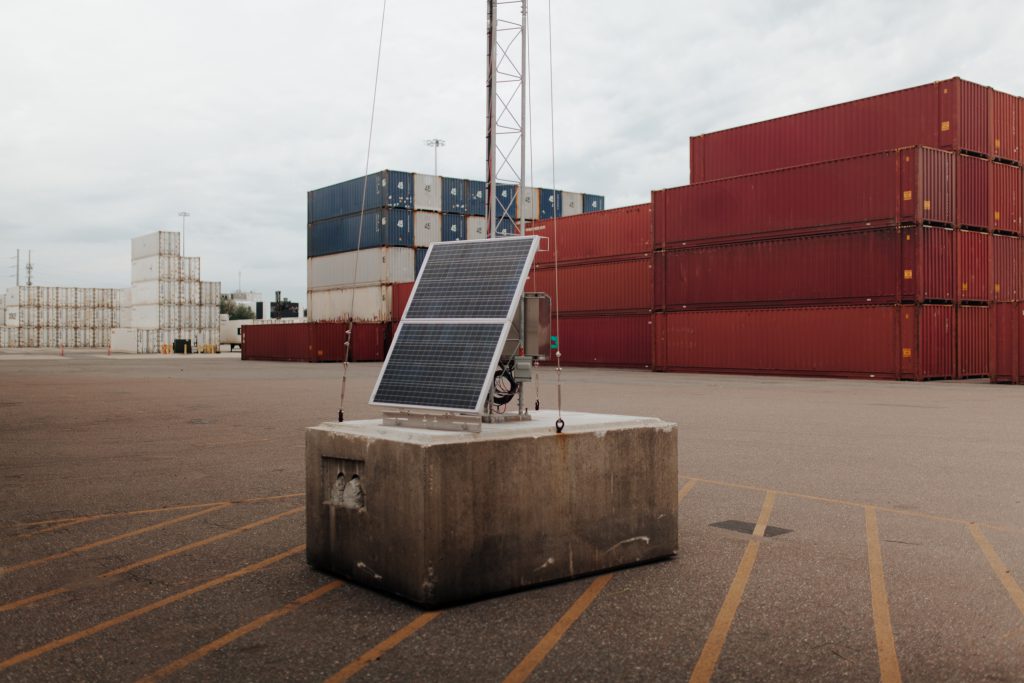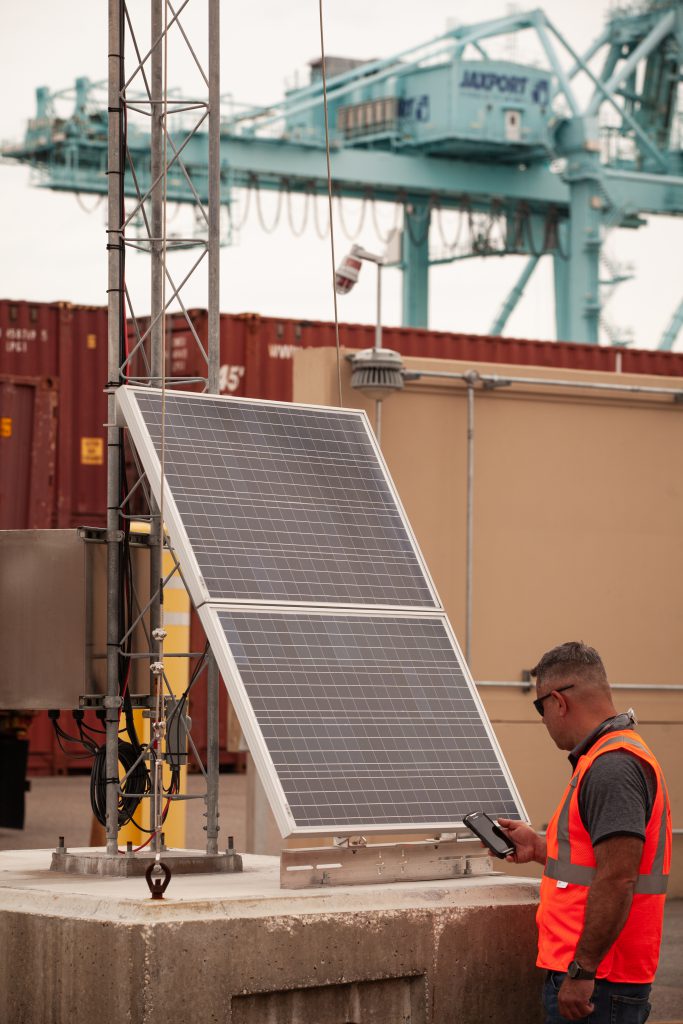Rapid Deploy Use-Case: Ship-to-Shore WiFi
Rapid Deploy Use-Case:
Ship-to-Shore Wi-Fi
Outdoor rail and intermodal terminals present complex, ever-changing conditions when deploying and maintaining wireless network infrastructure. But marine terminals take those challenges to an entirely new level, exposing infrastructure to corrosive elements and raising the bar for wireless connectivity between massive shipping vessels and on-shore operations.
Even with these added difficulties, marine terminals still face pressure to keep shipped goods moving, on time, on track, and reliably delivered for both carriers and shippers. To meet these customer expectations and create an operational advantage in an increasingly competitive market, one shipping and logistics customer approached Buckeye Mountain about partnering on a unique ship-to-shore WiFi project that would provide consistent, seamless connectivity for a marine terminal and customer ships docked in its San Juan, Puerto Rico port.
“They had already tried cellular,” says Steve Hill, a consultant for Buckeye Mountain. “One provider put in cellular-based access points as a connectivity solution for its customers. But those failed miserably. After that, Buckeye Mountain was given the opportunity to deliver a solution.”
Steve Hill, Director Wireless Engineering
Read on to learn how Buckeye Mountain partnered with the marine terminal to design and launch a successful, innovative ship-to-shore WiFi solution.
The Problem: Ensuring consistent WiFi connectivity across a complicated marine environment
Marine terminal environments are always in motion: ships are moving in and out, cranes are loading and unloading containers, and container stacks create constant change to the terminal yard landscape.
These dynamics create significant challenges when planning and implementing wireless infrastructure. Reallocated container stacks can interrupt wireless signals, creating spots all over the yard where a lost connection can disrupt operations. Ships, meanwhile, can struggle to secure a reliable connection as they enter the port. Even when a signal does reach the ship, the connection may only be available in certain locations—and moving containers and cranes in the yard can disrupt that connection at any moment.
Initially, the customer—a shipping and logistics operator—tried to address these connectivity issues by installing cellular access points in its terminal crane offices in Puerto Rico. When that failed, they needed to quickly find and deploy an alternative connectivity solution.
“The terminal was using a lot of handheld devices to scan containers as they came off the ship,” says Hill. “Cellular wasn’t working. The handheld scanners kept dropping connections, which threw a wrench into the whole terminal’s operations. It wasn’t sustainable.”
Steve Hill, Director Wireless Engineering
During a site visit to evaluate the terminal environment, Buckeye Mountain’s experts identified a number of unique challenges to address through its solution design process, beginning with the unreliable power and wireless infrastructure in Puerto Rico—both of which had contributed to the failures of past connectivity solutions.
Meanwhile, the high temperatures and high salt content of the air created highly corrosive conditions that meant certain materials couldn’t be used when deploying wireless infrastructure.
“When you have multiple metals like stainless steel and aluminum and regular steel, if you don’t have the right metals connecting to the right metals, things corrode very, very quickly,” Hill says. “Within six months, something completely rusts off. Once we got there and we saw so much corrosion everywhere, we took some time to think it through.”
Delivering Short-term WiFi Connectivity and Lasting Infrastructure

This customer needed a fast solution to its urgent connectivity challenges. That’s exactly what our on-the-ground experts delivered: Within 48 to 72 hours, Buckeye’s team had core connectivity equipment installed and up and running, implementing Rapid Deploy technology to deliver a stable WiFi network covering the dock and nearby areas.
“Most of that was Rapid MiniMaxes,” says Hill. “We identified vertical assets like poles—including some telephone poles that had been broken off from previous hurricanes—where we were able to install solar panels and other equipment. It was really an engineer-as-you-go kind of environment—but a lot of that initial network still stands today, six years later.”
While that initial 72-hour project addressed the customer’s most urgent connectivity needs, the shipping and logistics company still wanted to partner with Buckeye on more long-term initiatives to improve its port operations. The first phase of these connectivity projects focused on targeted solution delivery based on the customer’s evolving needs, including expansions to its WiFi coverage area and upgraded infrastructure that could support HD video surveillance.
Eventually, the customer shifted its focus toward planning connectivity investments that could support the company’s future needs in its Puerto Rico terminal. Those efforts included implementing 60 GHz technology that offered better short-range performance, consistency, and security within the terminal yard.
“Even though 60 GHz is designed for fixed point‑to‑point connectivity, we installed a test link to a moving crane to see what you could expect when a crane is moving 20 miles an hour,” says Hill. “But it performed really well.”
Soon after the infrastructure for 60 GHz spectrum was installed, the customer approached Buckeye Mountain about setting up wireless connectivity for a new PBAM trailer in its terminal yard. Although the customer had initially planned on using trenched fiber-optic cable to connect the PBAM trailer to the rest of the yard, the high cost of that infrastructure project prompted the customer to see if wireless connectivity was an option.
“The purpose of the PBAM trailer was to perform all of the remote diagnostics and monitoring for the yard’s three dock cranes, and to then relay that traffic back to the manufacturer’s headquarters,” Hill says. “For that reason, the trailer needed very reliable, low-latency, high-speed connectivity.”
Buckeye turned to its new 60 GHz spectrum, installing 60 GHz radios that created direct paths to the marine operations building and terminal cranes. Those connections now form the backbone of a 7 Gbps ring around the port, replacing a slower and less secure 5 GHz backhaul.
“The air‑fiber ring is far more reliable and less vulnerable than buried fiber,” says Hill. “Unlike fiber cable, you can’t ‘cut’ the air.”
Reliable Ship-to-Shore WiFi, Built on a Carrier-Grade Backhaul Network

Buckeye Mountain’s value as a wireless connectivity provider is about much more than the technologies we implement. We also bring a proven methodology to up-front planning and solution design, leveraging path-loss calculations, interference studies, and site modeling to inform our site visits and ensure we’re set up to engineer an effective solution for our customers.
We take pride in offering a deep engineering bench of experts offering certified credentials and experience using top-tier predictive tools. As a result, we were able to provide this customer with accurate forecasting of the increased connection uptime and terminal throughput they could expect from our infrastructure deployment.
In the case of its Puerto Rico marine terminal, Buckeye Mountain guaranteed the customer “five nines” reliability—or 99.999 percent uptime.
“That equates to just a few minutes of allowable downtime per year, including things like software upgrades and equipment failures,” Hill says. “‘Five nines’ is considered the gold standard in reliability. It’s typically associated with carrier-grade, fiber-based networks. That’s the level of performance we’re aiming for when we design our networks.”
Steve Hill, Director Wireless Engineering
In any infrastructure delivery project, Buckeye Mountain’s default goal is creating multi-path, multi-radio redundancy across the network, ensuring uptime even when the facility suffers from equipment failures, environmental disturbances, or even extreme scenarios like lightning strikes and severe weather.
From an engineering and design perspective, uptime and throughput always come first,” says Hill. “Cost is a secondary consideration. If a customer pushes back on pricing, we explain why the network is designed the way it is—and what risks come with cutting corners.”
Hill also notes that many of Buckeye’s hardware solutions are patented or patent-pending, meaning their customers have exclusive access to innovative technologies. Buckeye’s relationship with other hardware manufacturers also provides an inside edge: in the case of this Puerto Rico terminal, Buckeye’s experts had early access to emerging 60 GHz solutions that allowed the customer to plan around these solutions and deploy them as soon as they were available – resulting in cutting-edge infrastructure that only Buckeye could provide.
As Your Connectivity Needs Evolve, You Can Count on Buckeye Mountain
Wireless technology is changing all the time. So are the connectivity needs of marine, rail, and intermodal terminals.
Your on-the-ground operations need wireless infrastructure that is fast, reliable, and flexible to change. That’s exactly what Buckeye Mountain offers—and it’s why we view each customer relationship as a long-term partnership built on trust, credibility, and service.
We’re invested in supporting your company’s success not only today, but years into the future. Whether you’re seeking immediate connectivity help, long-term infrastructure transformation, or both, we want to be your partner in navigating that change and maximizing performance across your yard.
Find out how Buckeye Mountain can design and deliver a custom solution to meet your most specialized connectivity needs.

